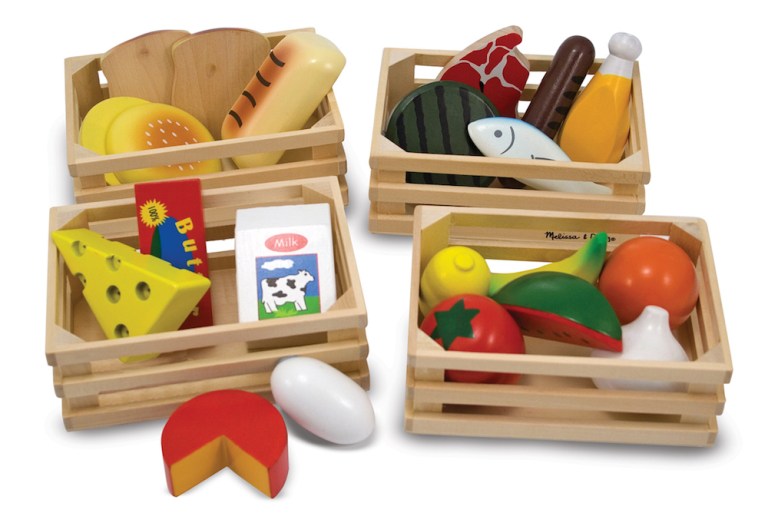
“We want our products to be here tomorrow. We call them evergreen products,” Melissa says. “People call and ask, “What’s hot this year?’ And I say, ‘I have no idea.’ I’m looking backwards at what was amazing a century ago and trying to reinvent that.” Summer is upon us, the surest sign of which is the millions of children who have spent the last few weeks pouring out of classrooms as the school year comes to and end. Parents everywhere are thus faced with the annual two-headed dragon to slay: making sure their kids are adequately stimulated over the summer so as to not destroy the house from boredom; and to make sure their kids retain as much of the previous school year’s learning as humanly imaginable.
But while most parents spend the summer dreading boredom – and the various expensive interventions they will inevitably face agains it – parents of six Melissa and Doug Bernstein literally love boredom. Boredom is their friend.
Not, however, because they are particularly sadistic sorts – but because the Bernsteins are the titular Melissa and Doug behind Melissa & Doug toys, and there is little in the world better for their business than bored kids. But, Doug and Melissa Bernstein noted in an interview – boredom isn’t just good for the bottom line, it is good for kids too.
“We believe that boredom is a great thing because from boredom, all creativity comes,” Doug Bernstein said.
“It is like staring at a blank canvas and saying, ‘Oh my goodness, I need to fill this up. What do I do?’” Melissa Bernstein said.
Answering that “What should I do?” is the question that the hot toy company has spent the better part of the last 30 years trying to answer, one low-tech toy at a time. Because while other toy makers have consistently strived to create the newest, most cutting-edge toys in the market, the Bernsteins have taken a slightly different approach. They aren’t looking to create the next new toy. If anything, they take a somewhat critical view of the sheer amount of screens children get to look at day in and day out.
Instead, they are hoping to help children re-discover playing with their imaginations in the way children in a less-connected, wired and electronic world did.
“We want our products to be here tomorrow. We call them evergreen products,” Melissa says. “People call and ask, ‘What’s hot this year?’ And I say, ‘I have no idea.’ I’m looking backwards at what was amazing a century ago and trying to reinvent that.”
And the sales figures back up the claim. The most popular toys in Melissa & Doug’s eCommerce line on Amazon is a broom and mop set that help children clean along with their parents, and a brightly colored game that is essentially a variation on pick-up sticks from a by-gone era. The goal, she said, is to give children toys that don’t play for them but instead really allow children to play with them.
Not every toy works – the brand puts out something in the order of 200 new products a year, and some of them crash and burn. But the team at Melissa & Doug doesn’t hide those failures, despite being low-tech Connecticut-based toys makers they have the attitude of Silicon Valley tech investors and entrepreneurs that tells them failure is a good thing because it is educational.
“In product development; you have to fail in order to succeed,” Melissa said, noting that her office is filled with several hundred toys that didn’t quite do the surprising and delighting heavy lifting they had hoped for.
“I have a wall of shame and despair – things I don’t quite understand why they didn’t make it. So every day I can say, ‘Is there a different way I can imagine them to make them successful today?’”
They do, however, submit to the options of experts. In 28 years in business they’ve done no marketing studies. They also aren’t a highly advertised brand – and have seen most of their growth over the last three decades pushed by word of mouth, particularly as the STEM movement in toys has taken off and parents are looking for their children to learn as they play.
Which in some sense may make Melissa & Doug seem like something of an odd fit with the rest of the STEM toy makers with which they are grouped. Mostly made of wood and cloth, the toys won’t teach a child to code and has very little in the way of technological bells and whistles.
But what the toys do – and do very well by nature of being low tech, according to the Bernsteins, is encourage children to imagine and build their own play worlds instead of seeing them already designed.
It wasn’t always an easy sell. The firm started out with a single wooden puzzle and a work space in Doug Bernstein’s father’s garage, which was convenient because that is also where they stored the “company car.”
“When we first started making products, we threw them in the back of my father’s old Malibu station wagon and … we’d go into stores,” Doug said.
And while they once had to ”literally beg” those stores to carry their products, today they are a $350-million business owned by private equity and still growing.
Because children will always get bored – Melissa & Doug will be ready to turn that into a learning and business opportunity.